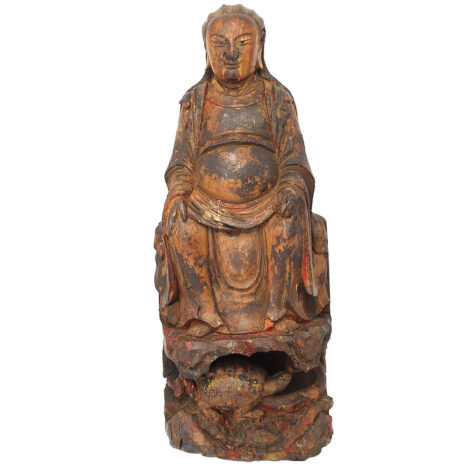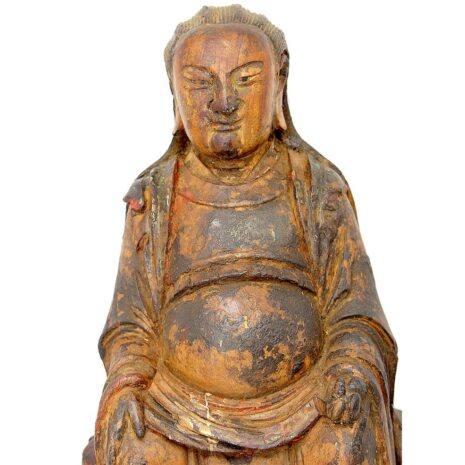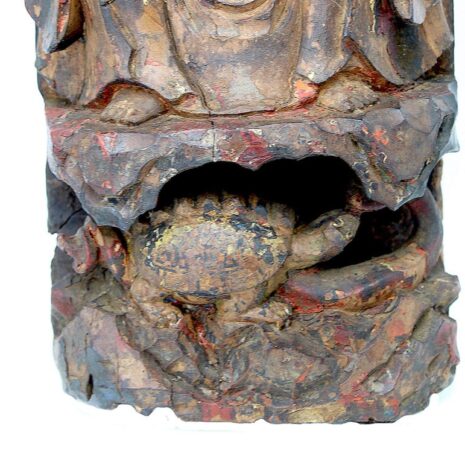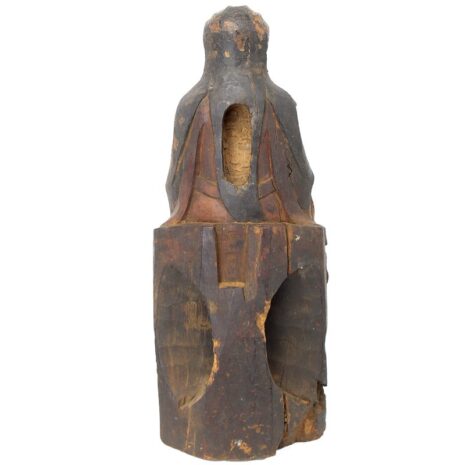Antique Wood Zhenwu, The Taoist “Perfected Warrior” China (19066B)
Original price was: $575.00.$495.00Current price is: $495.00.
H: 13″ W: 5″ D: 4.8″ | FREE SHIPPING WITHIN CONTINENTAL U.S.
Provincial carving of Zhenwu the Perfected Warrior, one of the most popular Taoist deities in the Ming/Qing dynasties, iconically shown standing on a snake and turtle, symbolizing those over whom he presides.
Description
Zhenwu (aka Xuanwu, Wuandi and Zhenwudadi) is one of the most revered Chinese Taoist figures, venerated for his ability to heal as well as to protect his country and the emperor.Zhenwu is known by many names and titles: Emperor of the Dark Heaven, Northern Emperor and the most commonly True Warrior and Perfected Warrior. One of the most popular Taoist deities during the Ming and Qing dynasties, he was depicted in all sizes – large porcelains and bronze imperial images and in small renditions for personal worship on home altars or shrines. Zhenwu is a syncretic deity, still venerated today by Taoist, Buddhist and Popular Religion devotees.
He is most often presented seated on a throne with a large snake coiled around the smaller turtle underneath his bare feet, his right on the snake and his left on the tortoise. This pair of mythical animals symbolizes those over whom he presided including “…both celestial officers under his command [and] former demons that were conquered by him.” (Stevens, p.19.) Because tortoises were believed to live for 10,000 years, they became an early symbol of longevity. Local provincial artisans took liberties in their iconographic representations with more humble and relatable images. (Silvers p. 23) This image is a slight departure as they are presented nose to nose underneath his throne and the substantial turtle sits on top, his head raised to touch the downward-facing reptile.
There are various depictions of his attire, but here he wears a plain black robe with an official’s belt which he holds in his hand. His long black hair flows down his back covering the carved cavity, indicating the image was consecrated. The face is carved with well-defined features including the eyes and lips set in a slight smile. Some of the original gilt and red can be detected under the black robes and remaining lacquer. Chinese lacquer naturally darkens over time, especially when an image has been exposed to burning incense and candles .
The back is designed for easy handling and transporting. There is a crack there, paint losses, and old minor insect damage expected for wood pieces of this age and use. Much of the lacquer and paint has been removed and the lacquer has naturally darkens over time. Otherwise it is a rare and an interesting piece with a wonderful patina in very good condition.
Click here for the Blog Consecrating Wooden Images to Imbue Them with A Life Force
Sources:
Dr. Gabi Greve, “Tsurukame – Crane, Tortoise and Snake,” Daruma Museum,
Jeremy Roberts, Chinese Mythology A to Z, New York, Facts on File, 2004.
Dale Saunders, Mudra: A Study of Symbolic Gestures in Japanese Buddhist Sculpture, Princeton, Princeton University Press, 1960
Brock Silvers, The Taoist Manual: An Illustrated Guide, Applying Taoism to Daily Life, Honolulu, Sacred Mountain Press, 2005.
Keith G. Stevens, Images of Asia Chinese Mythological Gods, Oxford University Press, New York, 2001.
The Art Institute of Chicago, Taoism and the Arts of China: The Taoist Renaissance, 2000.
Additional information
| Weight | 5 lbs |
|---|---|
| Dimensions | 14 × 10 × 6 in |
| Place of Origin | China |
| Period | Antique, Qing Dynasty |
| Date | 18th century |
| Materials and Technique | Wood |
| Dimensions (inches) | Ht: 13” W: 5” D: 4.875” |
| Dimensions (metric) | Ht: 33.02cm W: 12.7cm D: 12.383cm |
| Weight | 1lbs 15oz |
| Condition | Very good, see description |
| Item Number | 19066BME |
| Shipping Box Size |












